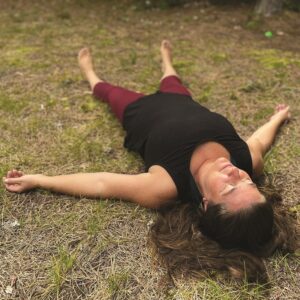Sometimes you just need to lay your body down. August on Cape Cod? Definitely one of those times.
Savasana, also known as the Corpse Pose, is one of the most essential and profound asanas in yoga practice. The pose involves lying flat on the back, arms resting loosely by the sides, legs and feet at ease in a way that the body is fully supported, the muscles are soft, and the mind is completely calm and receptive.
This pose is typically performed at the end of a yoga session for relaxation and integration, but you really can choose to do this pose at any time.

We often hear that modern life has become increasingly fast-paced and demanding. Stress-related issues are common. True. But it is also worth noting: yoga has been around for thousands of years, and the first written descriptions of Savasana are many hundreds of years old. To be human is to need rest.
In this pose, the body and mind enter a state of deep relaxation, triggering the parasympathetic nervous system and promoting the release of endorphins, which are natural stress-relievers. The relaxation induced by Savasana also helps in achieving better sleep, allowing the body to recover and rejuvenate during the night. Neuroscience has provided significant insights into the critical role of rest in promoting brain health, cognitive function, emotional well-being, and overall mental performance. Ancient wisdom persists. Savasana is a useful tool for being human today.
Lying still in this pose, we are encouraged to observe the present moment and our breath, to notice thoughts and sensations without judgment. This heightened mindfulness extends into daily life, relationships, and decision-making.
One summer several years ago when my children were young and there were many small and large requests fired at me at the end of long working days, I made a habit of lying down on the ground before answering.
“Can we go play minigolf?”
“Let me get back to you.” And away I’d go. Outdoors and down onto my back. The key to mastering Savasana is in the art of surrendering and letting go. I needed a moment to be free. Free from the roles and responsibilities, identities and expectations, physical and mental demands of the day. This letting go allowed me to reconnect with grace. First to myself and then, with clarity and calm, to my people. We were all better for it. And I am certain I said yes more than I would have if I had not given myself the time to rest.
Tap into this pose’s transformative effects and find balance, peace, and harmony within.
First, find a comfortable place. You don’t need a yoga mat or the perfect conditions, just a spot where you can allow yourself to surrender for a while. Lie down on your back. Extend your legs with some support behind the knees if you need it. Make space between the legs, and let your feet fall naturally. Allow your arms to relax beside your body, palms up, if that is comfortable. Let your fingers curl in a natural, relaxed way. Settle your head and neck in a neutral position, aligned with your spine. Place a small pillow or folded towel under your head, if needed, to support the natural curve of your neck. Take time to feel your body’s connection to the ground and the supports beneath you.
Now, close your eyes and turn your attention inward. Take a few deep breaths to release any tension in your body. Starting from your toes, consciously relax each body part, moving up through your legs, hips, abdomen, chest, arms, shoulders, and neck. Finally, relax your facial muscles and allow your whole body to feel completely at ease.
Then, shift your attention to your breath. Breathe naturally, and observe the rhythm of your breath without trying to control it. Feel the gentle rise and fall of your abdomen with each breath.
Once you’ve settled into the pose, remain still. If any discomfort arises and doesn’t resolve within a few breaths, adjust your position slightly to find a more comfortable posture but avoid fidgeting. Stay in the pose for 5 to 10 minutes, longer if you wish. Give yourself enough time to truly relax and experience the benefits of the pose.
Savasana is an essential part of every yoga practice and an excellent way to end any physical activity or stressful day. It can be a challenging pose for some people, however, especially those who suffer from a busy mind. With regular practice, it becomes easier to find relaxation and stillness in this pose. You can gradually learn to let go and allow the mind to settle naturally. Be patient and persistent on your path towards rejuvenation and calmness. The rewards extend far beyond the yoga mat.
